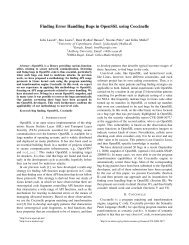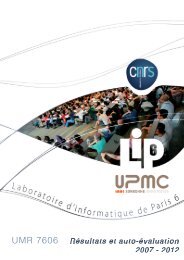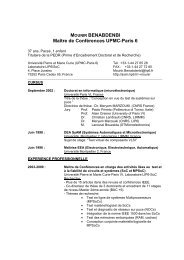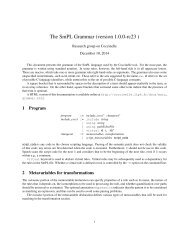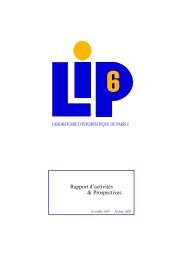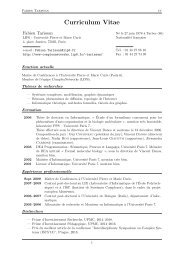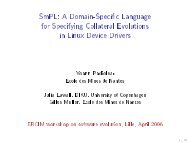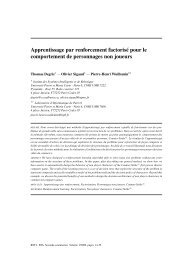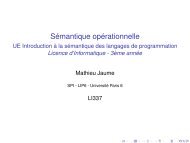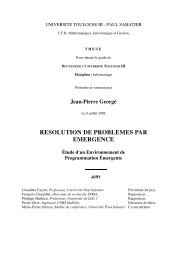Proceedings [PDF] - Measurement and Analysis of P2P Activity ...
Proceedings [PDF] - Measurement and Analysis of P2P Activity ...
Proceedings [PDF] - Measurement and Analysis of P2P Activity ...
You also want an ePaper? Increase the reach of your titles
YUMPU automatically turns print PDFs into web optimized ePapers that Google loves.
International Conference Advances in the <strong>Analysis</strong> <strong>of</strong> Online Paedophile <strong>Activity</strong> Paris, France; 2-3 June, 2009<br />
period <strong>and</strong> numbers over 3,000,000 records. This data set we will term the <strong>P2P</strong><br />
Submissions List (PSL).<br />
Identification <strong>of</strong> Thematic Categories<br />
Our first priority was to try to impose some order upon the rich variety <strong>of</strong> the data<br />
collected. In the first instance, this involved an analysis <strong>of</strong> the STL in which the list was<br />
trawled for words with a sexual connotation. An exhaustive search <strong>of</strong> the list was carried<br />
out to identify terms that indicated sexually related material. In addition, a computer<br />
program was written for our Windows system in order to isolate words or part-words<br />
according to a given theme.<br />
The result <strong>of</strong> this process was the identification <strong>of</strong> a number <strong>of</strong> specific themes defined by<br />
their sexual <strong>and</strong> fetishistic content. Specific terms <strong>and</strong> words associated with these<br />
categories were identified from the STL data. It should be born in mind that these are not a<br />
final categorization an on-going refinement continues among the partners in MAPAP<br />
project. It should be clear that the motive behind using such search terms may vary <strong>and</strong><br />
the assumption that these terms were being used to seek out sexually stimulating material is<br />
likely to be erroneous in some cases. However, given the large number <strong>of</strong> cases considered<br />
it was felt that this would constitute a manageable degree <strong>of</strong> error <strong>and</strong> would not invalidate<br />
the current methodology.<br />
Identification <strong>of</strong> Individual’s Sexual Interest Pr<strong>of</strong>iles<br />
In order to provide a sexual interest pr<strong>of</strong>ile for each record we next turned to the PSL data<br />
set. This contains over 3,000,000 records <strong>of</strong> submissions to eDonkey. A computer<br />
program was written for our Windows platform to scan these records in a serial fashion to<br />
find instances <strong>of</strong> the words identified as representing the thematic categories.<br />
For each case, a record containing variables representing the 25 themes was created. Each<br />
variable was initially set to zero. If a sought after word occured in the PSL data set for that<br />
case, then the variable representing the theme in which it is placed is incremented by one.<br />
If, after scanning, a case has no occurrence <strong>of</strong> the critical words it is jettisoned <strong>and</strong> the<br />
program moves onto the next case. If, on the other h<strong>and</strong>, the case does contain critical<br />
words the record <strong>of</strong> 25 themes is written to a second data file. In this way the program<br />
identifies those cases where a user has made one or more sexually related submissions as<br />
defined by the terms recorded in appendix 1.<br />
Thus a second data file was generated containing only these cases that manifest at least one<br />
<strong>of</strong> the 25 categories <strong>and</strong> this contained 62940 cases. Each <strong>of</strong> the 25 variables contains the<br />
frequency with which terms are submitted within each <strong>of</strong> the 25 thematic categories. In<br />
order to control for the fact that each theme is built <strong>of</strong> differing numbers <strong>of</strong> terms we chose<br />
to represent the data in binary form thus:-<br />
If y i >0 then x i =1<br />
If y i =0 then x i =0<br />
67


![Proceedings [PDF] - Measurement and Analysis of P2P Activity ...](https://img.yumpu.com/32964521/67/500x640/proceedings-pdf-measurement-and-analysis-of-p2p-activity-.jpg)

